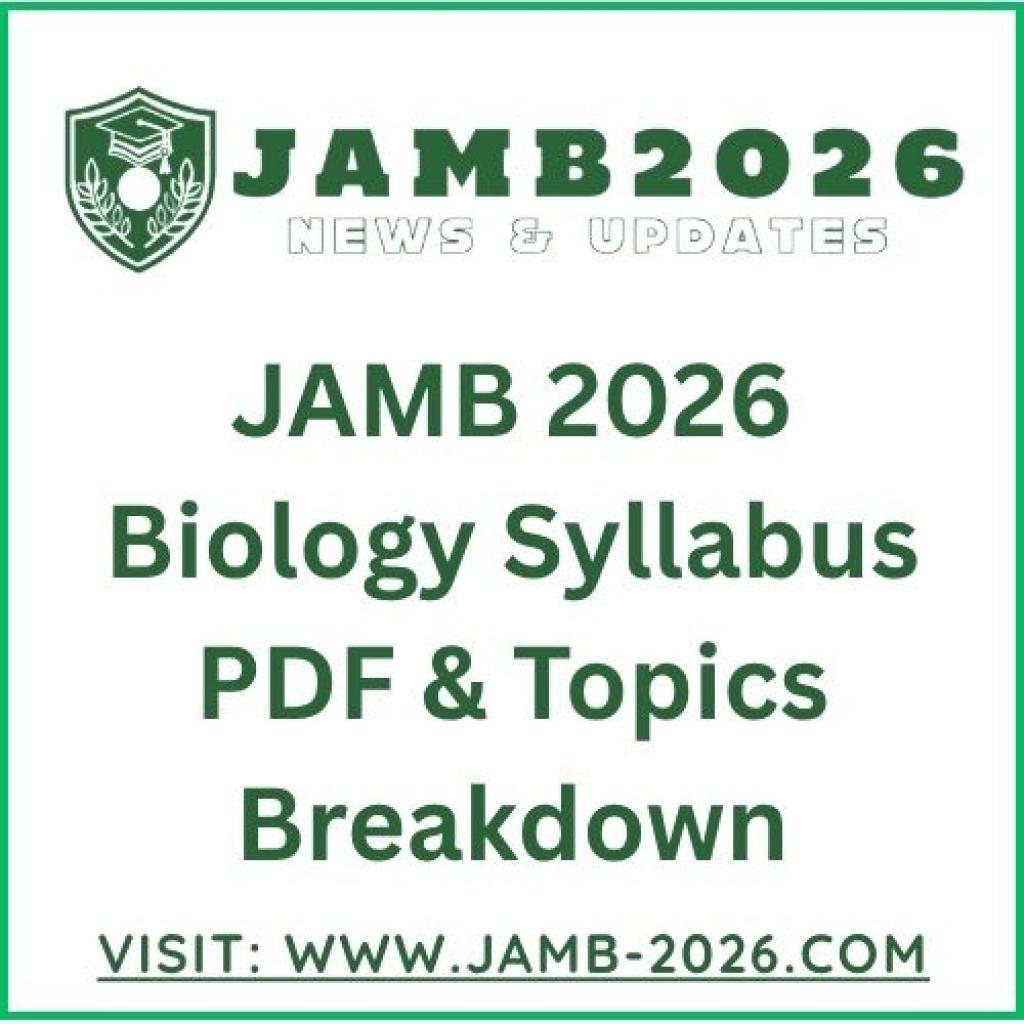JAMB 2026 Physics Syllabus PDF & Topics Breakdown
Explore the complete 2026/2027 JAMB Physics syllabus, including approved topics, key objectives, and recommended textbooks to help you prepare effectively for the UTME exam. lets keep reading below

We are happy to present the 2026/2027 JAMB Biology syllabus, complete with approved topics, key objectives, and recommended textbooks to help you prepare effectively for the 2026 UTME.
Table of contents [Show]
JAMB 2026 Biology Syllabus PDF & Topics Breakdown: In today’s article, the JAMB 2026 editorial team is here to present to candidates the updated Biology syllabus for the 2026/2027 academic year. This syllabus has been carefully compiled to guide students in their preparation, ensuring that they focus on the right topics and subtopics that are most relevant for the upcoming UTME.
If you are preparing for the upcoming 2026 JAMB exams, don’t panic you are on the right track, as the JAMB 2026 Editorial Team is here to guide you toward excellent academic performance.
Furthermore, many students tend to neglect Biology during exam preparation, believing it is very simple and that they can read it within a day, either during or just before the exam period. This is a very wrong decision and must be addressed. That is why we, at the JAMB 2026 Exams Team, have decided to update the general public with the most recent 2026 JAMB Biology syllabus.
So, let’s dive into the full list of the 2026 JAMB Biology syllabus for easy understanding and topic breakdown. We have carefully arranged the syllabus in proper order, so please take a moment to go through it.
This is the first topic on the JAMB Biology syllabus and must not be overlooked, as it covers a wide variety of subtopics. Here is what you should study before the exam: living organisms, characteristics of living organisms, cell, cell theory, and cell structure, as well as the functions of cell components.
Evolution among organisms is a very broad topic, and students need to understand it thoroughly because it can be confusing. I strongly advise all candidates not to overlook it and to study smart, as it is key to achieving a good result. Here is what to study under this topic: Monera (prokaryotes), Protista (protozoans and protophyta), Fungi, Plantae, and Animalia.
As the name implies, this topic covers a lot of areas, and students should not fail to study it before the exam. Here is what to focus on: Structural, functional, and behavioural adaptations of organisms; adaptive colouration and its functions; behavioural adaptations in social animals; and structural adaptations in organisms.
This topic is interesting and enjoyable. Every student preparing for the 2026 JAMB exam must not overlook it because JAMB will surely ask questions based on it. Here is what to study: Root, stem, leaf, and internal structure of a mammal.
This is a nice and interesting topic, and it always appears in the exam. Every student must study it carefully. Here is what to focus on: Modes of nutrition, types of nutrition, and detailed study of animal nutrition.
As a student preparing for the upcoming 2026 JAMB exam, this is an important topic and must not be overlooked. Here is what you should study under this topic: Need for transportation, materials for transportation (excretory products, gases, manufactured food, digested food, nutrients, water, and hormones), channels for transportation (mammalian circulatory system – heart, arteries, veins, and capillaries; plant vascular system – phloem and xylem), media and processes or mechanisms for transportation.
This is an important topic and must not be overlooked because it is easy to understand and assimilate due to its simplicity. Here is what to study under this topic: Definition of respiration, respiratory organs and surfaces, the mechanism of gaseous exchange in plants and mammals, aerobic respiration, and anaerobic respiration.
This topic appears in different forms during exams and must not be overlooked. Excretion is taught from primary school to secondary school; in fact, we can call excretion and respiration “twin topics.” Here is what you should read for exams: Definition of excretion, types of excretory structures, excretory mechanisms, and excretory products of plants.
Here is what to read under this topic: Tropic, tactic, nastic, and sleep movements in plants; supporting tissues in animals; and types and functions of the skeleton.
Students enjoy this topic because it has a deeper meaning and is mostly applied to humans due to its important nature. Most Christian teachers fail to teach this topic because they feel uncomfortable mentioning certain words. However, I must tell you that it is a must-answer question in exams. Here is what to read about this topic: definition of reproduction, asexual reproduction, sexual reproduction in flowering plants, and reproduction in mammals.
Reproduction: Here is what you should read under this topic: meaning of growth, germination of seeds, and conditions necessary for germination of seeds.
This is an important topic and should be studied closely as the exam approaches. Here is what you should read for the exam: nervous co-ordination, the sense organs, hormonal control, and homeostasis.
his is a vital topic that requires attention during your exam preparation. Here is what you should study: factors affecting the distribution of organisms (abiotic and biotic), symbiotic interactions of plants and animals, natural habitats, and the ecology of populations.
This topic may look common, but it is important that students do not overlook it because it often appears in exams. Here is what you should focus on: characteristics of different types of soil (sandy, loamy, clayey), components of the soil, and soil fertility.
Here is what you should study under this topic for the exam: diseases, pollution, and its control.
Explore the complete 2026/2027 JAMB Physics syllabus, including approved topics, key objectives, and recommended textbooks to help you prepare effectively for the UTME exam. lets keep reading below


